
Rostanga is a genus of sea slugs in the family Discodorididae. Some sources, such as The Sea Slug Forum still classify Rostanga in the family Dorididae.

The Polyceridae are a taxonomic family of sea slugs, dorid nudibranchs, marine gastropod mollusks within the superfamily Polyceroidea.
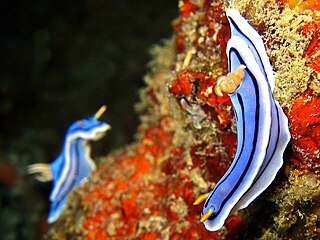
Chromodoris is a genus of very colourful sea slugs or dorid nudibranchs, marine gastropod molluscs, and the type genus of the family Chromodorididae. Within the genus Chromodoris, there are currently 101 classified species. Species within Chromodoris are commonly found in tropical and subtropical waters, living as members of reef communities and preying primarily on sponges. A molecular phylogeny of the family Chromodorididae resulted in this genus being restricted to a smaller number of species than formerly, most of which have longitudinal black lines on the mantle. Many former members of Chromodoris were transferred to Goniobranchus
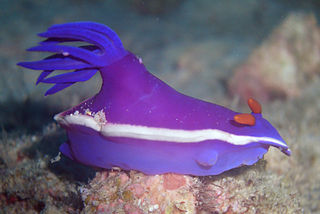
Hypselodoris is a genus of colourful sea slugs or dorid nudibranchs, marine gastropod mollusks in the family Chromodorididae. Modern usage follows a more restricted view of which species belong in this genus so there are numerous genus transfers.
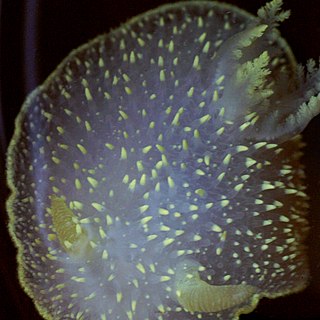
Acanthodoris is a genus of sea slugs, dorid nudibranchs, shell-less marine gastropod mollusks in the family Onchidorididae. The genus is believed to have originated in the Atlantic Ocean in the Cretaceous period and spread to the Pacific Ocean. The relationships of Acanthodoris to the other genera in the family Onchidorididae were evaluated by molecular phylogeny in 2015.
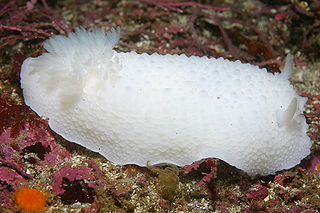
Doris is a genus of sea slugs, specifically dorid nudibranchs. These animals are marine gastropod molluscs in the family Dorididae.

The Facelinidae are a taxonomic family of colorful sea slugs. These are specifically aeolid nudibranchs. They are marine gastropod molluscs.

Goniodoris is a genus of sea slugs, specifically dorid nudibranchs, marine gastropod molluscs in the family Goniodorididae.

Tambja is a genus of colorful sea slugs, dorid nudibranchs, shell-less marine gastropod mollusks in the family Polyceridae.
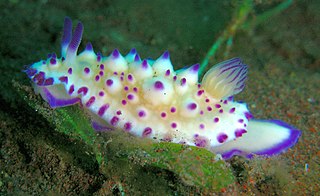
Mexichromis is a genus of colourful sea slugs, dorid nudibranchs, shell-less marine gastropod mollusks in the family Chromodorididae. Current synonymy follows a revision of Chromodorididae which used molecular phylogeny.

Hoplodoris is a genus of sea slugs, dorid nudibranchs, shell-less marine gastropod molluscs in the family Discodorididae.

Platydoris is a genus of sea slugs, dorid nudibranchs, shell-less marine gastropod mollusks in the family Discodorididae. These nudibranchs are large and often brightly coloured, but normally live concealed beneath rocks or loose coral, feeding on sponges. During the night they become more active, searching for new food sources or mates. Many species were described in the 19th century and a revision in 2002 added six new species.

Thordisa is a genus of sea slugs, dorid nudibranchs, shell-less marine gastropod mollusks in the family Discodorididae.

Felimare tricolor is a colourful species of sea slug or dorid nudibranch, a marine gastropod mollusc in the family Chromodorididae.

Aeolidia is a genus of sea slugs, aeolid nudibranchs, marine gastropod mollusks in the family Aeolidiidae.
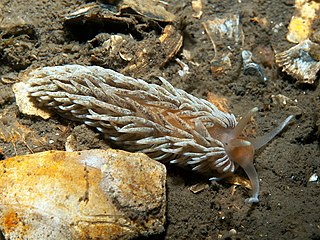
Aeolidiella is a genus of sea slugs, aeolid nudibranchs, marine gastropod molluscs in the family Aeolidiidae.

Berthella is a genus of sea slugs, marine gastropod mollusks in the family Pleurobranchidae.
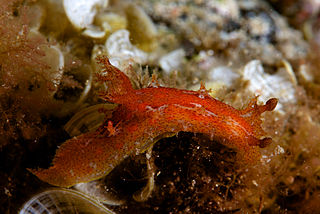
Plocamopherus is a genus of sea slugs, specifically nudibranchs, shell-less marine gastropod molluscs in the family Polyceridae, subfamily Triophinae. A unique character of Plocamopherus species is a globular bioluminescent organ at the tip of the pair of appendages which are placed just behind the gills. Many species are known to be nocturnal and several are from deep water. They feed on bryozoans.

Melanochlamys is a genus of headshield slugs in the family Aglajidae. Despite the appearance of its species, this genus must not be confused with nudibranchs.

Felimare is a genus of sea slugs, dorid nudibranchs, shell-less marine gastropod molluscs in the subfamily Miamirinae of the family Chromodorididae.




















